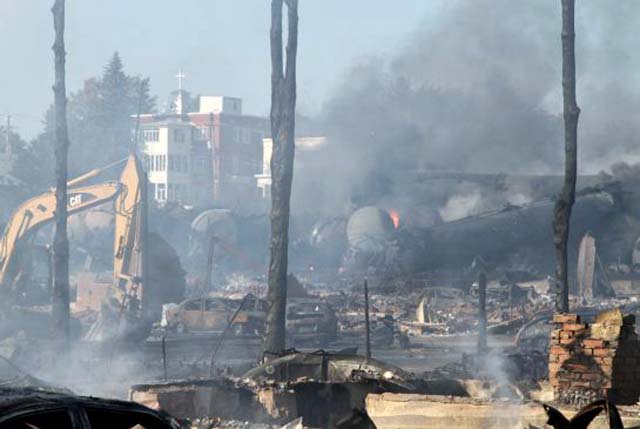

The derailment site - Date/Photographer unknown - Lake Megantic Police.
9 July 2013 Ottawa Approved Having Only One Engineer on Ill-Fated Train Ottawa Ontario - The rail company whose 73-car train devastated a Quebec town when it derailed convinced the federal government last year that it could safely operate trains with only one engineer on board, officials disclosed Tuesday.
Montreal Maine & Atlantic Railway (MMA) got the green light from Transport Canada for the reduced staffing in 2012.
"They had to meet with Transport Canada and demonstrate to us that they could do it safely," said Luc Bourdon, director general of rail safety in Transport Canada.
Senior Transport Canada officials acknowledged that MMA is only one of two companies allowed to operate with only one employee on a train. The other company is Quebec North Shore & Labrador Railway, officials said.
The government also said it was "very unusual", though not against the rules, for the company to leave the train unattended at night on a main rail line, as happened late Friday before the train got loose and careened into Lake Megantic.
Much of the village was destroyed when the cars carrying crude oil derailed and blew up, leaving at least 15 dead and dozens of people missing in an area police were calling a crime scene.
Despite the devastation, 1,200 residents were allowed to return to 610 households Tuesday. Another 800 will have to wait longer, and it's not known how many actually have already returned.
On Friday night, the sole engineer on MMA's ill-fated train parked it in nearby Nantes, Quebec, before heading off to sleep for the night. Sometime early Saturday, the train started moving and rolled into Lake Megantic before exploding.
The exact cause of the accident is under investigation by the federal Transportation Safety Board (TSB). MMA chairman Ed Burkhardt has said all safety precautions were complied with when the train was in Nantes.
Bourdon was asked if it's rare for a train to be left unattended, a practice that is said to be taboo in the United States.
"It's very unusual in Canada as well," he told reporters in a briefing in Ottawa. "It's not something that you will see a lot. It's pretty rare that they will leave a train like that."
It's seldom done because it could block the line for other trains, Bourdon added.
The company and local fire officials have different accounts of the events leading up to the runaway train.
Burkhardt said firefighters in Nantes shut down a locomotive while putting out the blaze, causing the brakes to release. He also said the engineer who'd brought the train into Nantes later towed nine cars from the explosion site in Lake Megantic to ensure they didn't catch fire.
Nantes fire chief Patrick Lambert said it's standard procedure to shut down a locomotive while fighting a fire in the cab, and a company employee was on the site.
But Lake Megantic fire chief Denis Lauzon said it was a volunteer firefighter who works for a company employed to tow cars along the tracks that moved the cars.
Burkhardt did not respond to repeated requests for comment Tuesday.
Yet the train in Nantes should not have moved, even it had lost air pressure to the brakes, federal officials said Tuesday.
That's because any train stopped for an extended period must have sufficient hand brakes applied "so it will not move," said Bourdon.
To ensure the hand brakes are properly set, the engineer will attempt to push and pull the train using the locomotive. "If it's moving, he's going to apply more hand brakes," he said.
He noted there are no rules requiring that locomotive cabs be locked while they are unattended.
The rail cars that exploded and burned have a checkered history. The TSB said the cars were all low-pressure tank cars, including the DOT-111A.
Both the TSB and the National Transportation Safety Board in the United States noted the car's steel shell will puncture in a crash because its walls are too thin. They also reported the ends also puncture easily and valves break in a rollover.
Over the years, the TSB has made recommendations to improve the car. Rob Johnston, a rail investigations manager at the TSB, said improvements are being made to the DOT-111A, such as reinforcing the ends and making thicker walls.
But those apply to only new cars.
The problem, he said, is the sheer number of DOT-111As on the rails, which the U.S. Department of Transportation estimates at 175,000 in North America.
"So you can have a new tank car next to a 20-year-old tank car," Johnston said.
Marie-France Dagenais, director-general of transportation of dangerous goods, said tanker cars carrying crude oil are not required to be double-hulled because they do not fall into the category of dangerous or toxic materials.
The railway has been involved in several incidents, most recently in June when a 13,000-litre diesel spill occurred in Frontenac, just east of Lake Megantic after a train derailment.
U.S. authorities charged the Maine-based company for a 2009 oil spill in Milo, Maine, eventually settling at a US$30,000 fine in 2011. It was also involved in a spill of more than 375 litres of oil in Easton, Maine, in 2011.
The company, which operated as Iron Road Railways between 1995 and a 2003 acquisition by Rail World Inc., was responsible for 11 incidents involving hazardous material since 1998. Eight of those occurred since Rail World acquired it.
Transport Canada said MMA was subject to routine audits and inspections but no more than any other rail company. In the last year, that included checks on 511 cars, 37 crossings, 20 locomotives, and 514 miles of track belonging to the rail firm.
The most recent inspection came on Friday, just hours before the accident, when Transport Canada officials examined the 73 cars. They could not say whether the locomotives pulling the freight cars were inspected at the time as well.
Les Whittington, Liam Casey, Jessica McDiarmid, Bruce Campion-Smith, and Tim Alamenciak.



Vancouver Island
British Columbia
Canada
| 
